Alienware x14 review: The thinnest 14-inch gaming laptop around
Expert’s Rating
Pros
- Attractive design
- Extremely slim and easy to carry
- Solid performance, especially for its size
- Future-proof wired and wireless connectivity
Cons
- Fan noise is a constant companion
- Cramped keyboard and touchpad
- Becomes very warm under load
- No Ethernet port, only one USB-A
Our Verdict
The Alienware x14 is a slim, quick gaming laptop that sounds ready to launch into orbit.
Best Prices Today: Alienware x14

$1899.99
Free
Dell Small Business
$2059.00
Free
Want the thinnest 14-inch gaming laptop money can buy? The Alienware x14 is it. It somehow stuffs up to an Intel Core i7-12700H and RTX 3060 into a chassis that’s only a hair thicker than a Dell XPS 13 from 2020. I assume a bag of holding is involved. But does the magic extend to performance – or does Alienware run out of mana?
Alienware x14 specs and features
The Alienware x14’s offers only a handful of configuration options. You can choose an Intel Core i5-12500H or i7-12700H processor and one of three Nvidia GPUs: the RTX 3050, 3050 Ti, and 3060. Storage runs up to 4TB and RAM runs up to 32GB.
- CPU: Intel Core i7-12700H
- Memory: 32GB
- Graphics/GPU: Nvidia RTX 3060
- Display: 14-inch 1080p 144Hz IPS LCD
- Storage: 1TB SSD
- Webcam: 720p
- Connectivity: 2x USB-C USB4/Thunderbolt 4, 1x USB-C USB 3.2 Gen 1, 1x USB-A USB 3.2 Gen 1, 1x HDMI 2.1, 1x MicroSD card reader, 3.5mm audio jack
- Networking: Wi-Fi 6E, Bluetooth 5.2
- Biometrics: IR camera, Windows Hello compatible
- Battery capacity: 80 watt-hours
- Dimensions: 12.65 inches x 10.34 x .57
- Weight: 4.06 pounds
- MSRP: $1,499 base, $1,999 as-tested
Pricing is competitive. The base Alienware x14 is just $1,499, which is much less than Razer’s Blade 14 and similar to Asus’ ROG Zephyrus G14. Our review unit, configured as shown in the bullet list above, was $1,999. That’s no bargain, but it’s a fair price for a compact gaming laptop.
Design and build quality
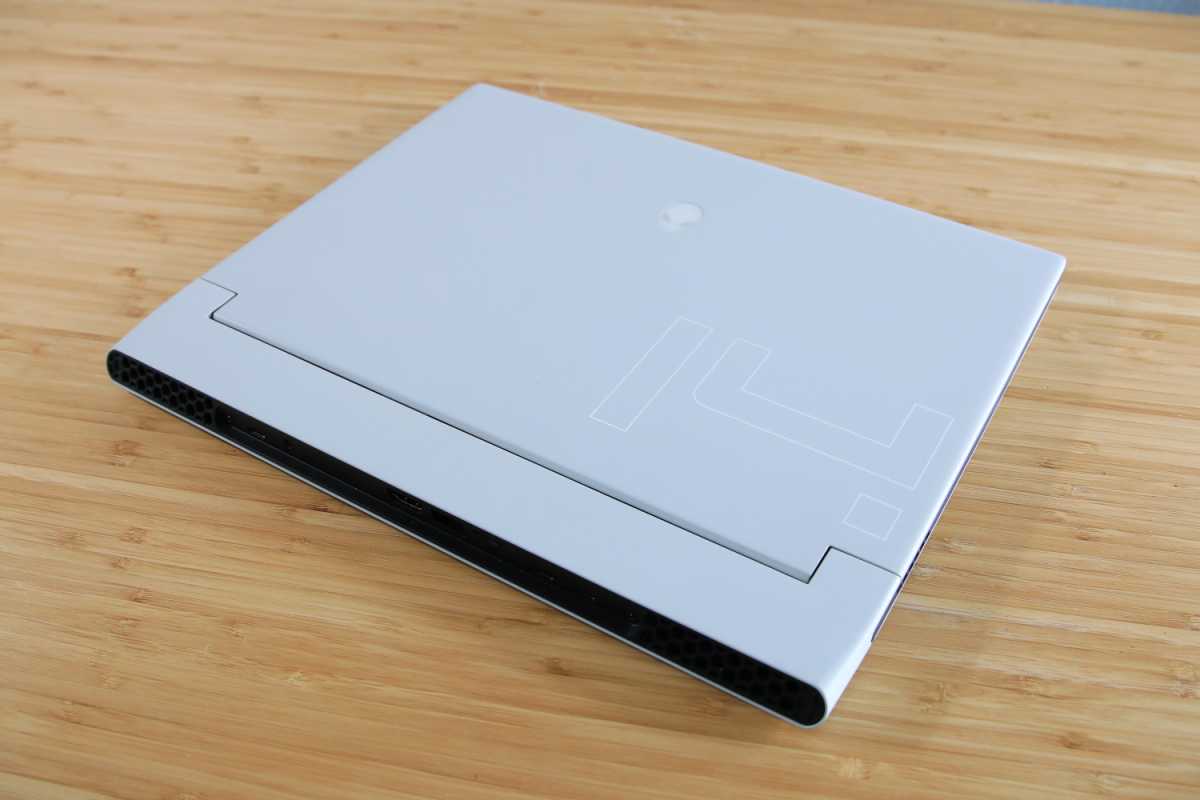
IDG / Matthew Smith
The Alienware x14 is a stunner. It harnesses the brand’s unique Legend design language in a tight, slim design. Every inch of the machine seems carefully considered. The x14 has none of the odd warts or sudden angles that spoil competing machines from Acer and Asus, yet it also avoids looking generic. It’s possibly the best gaming laptop design on the market today.
The chassis is built not just from plastic and aluminum but also stainless steel and a magnesium alloy. Magnesium is a material more commonly used by Lenovo’s ThinkPad line to provide rigidity with minimal weight. It lends a unique “grippy” feel that’s unlike an aluminum laptop. It can feel a bit odd – chalky, even – but has the benefit of making the laptop easy to pick up and carry.
I noticed flex in the display lid. This is one area that doesn’t quite match the x14’s otherwise luxurious feel. However, build quality is otherwise excellent with tight panel tolerances and no misaligned parts. The laptop’s lower half resists flex when handled from a corner or edge.
The Alienware x14 is extremely thin. It measures a mere .57 inches thick – just a few tenths of an inch thicker than Dell’s outgoing XPS 13. The x14 is noticeably slimmer than the Razer Blade 14 and Asus ROG Zephyrus G14. Weight comes in at about four pounds, which is well below average of a gaming laptop.
Keyboard and trackpad
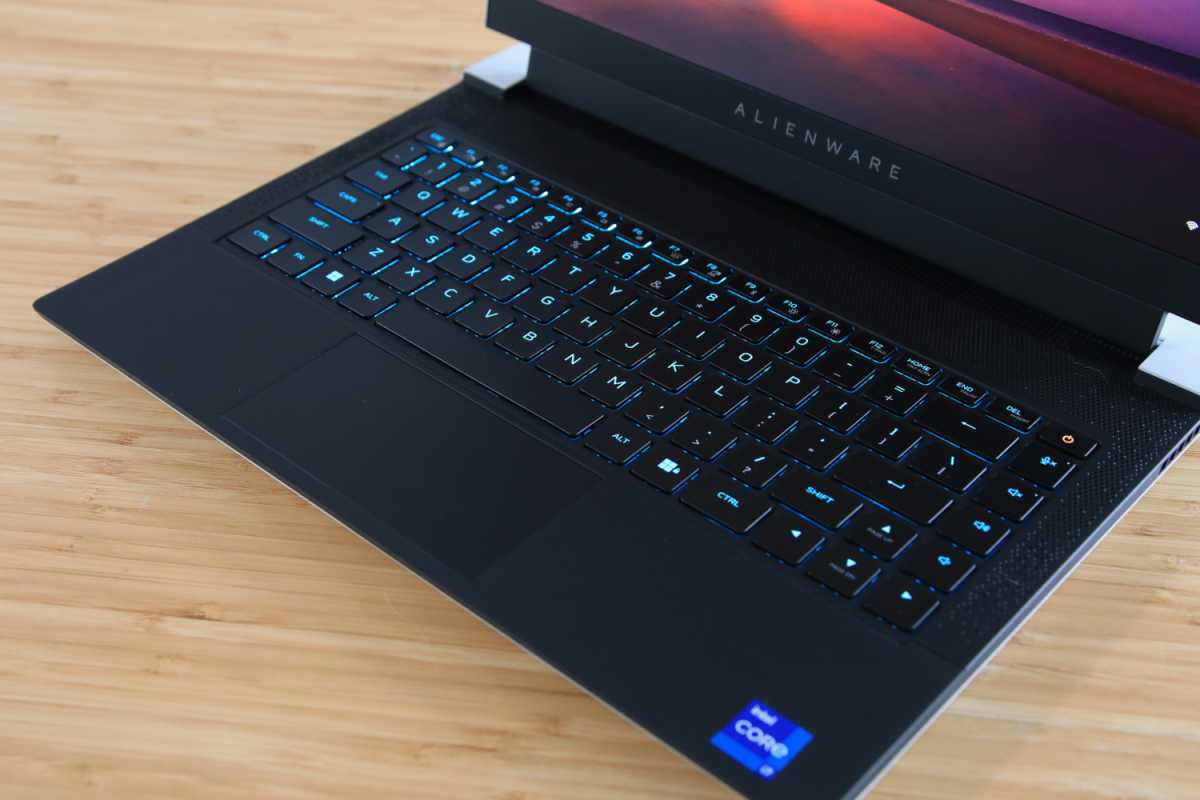
IDG / Matthew Smith
Shaving a gaming laptop as thin as Alienware’s x14 leaves minimal vertical space inside. This forces the laptop to embrace a key switch with just 1.2 millimeters of travel which, though not bad, is less than most gaming laptops. The result is a swift, short key action that bottoms with a firm, clicky sensation. It’s enjoyable to use but began to feel tiring after hours using the laptop.
The x14’s keyboard is pushed forward by the speakers and cool vent located between it and the display hinge. This leaves little space for the palmrest, which is far more shallow than usual. My usual typing position left the lower half of my palms dangling uncomfortably on the laptop’s edge. Typing can feel cramped, especially for owners with large hands.
A customizable RGB keyboard backlight is included but only offers one zone, which limits your options. The backlight is bright and most keys appear evenly lit. There’s modest light leak around the edges of each key.
Touchpad quality is harmed by this design choice, too. It’s four inches wide but only two inches deep, leaving little space for swiping vertically across the touchpad and using Windows’ multi-touch gestures. The touchpad is responsive, at least, and doesn’t register unintended inputs.
Display, audio
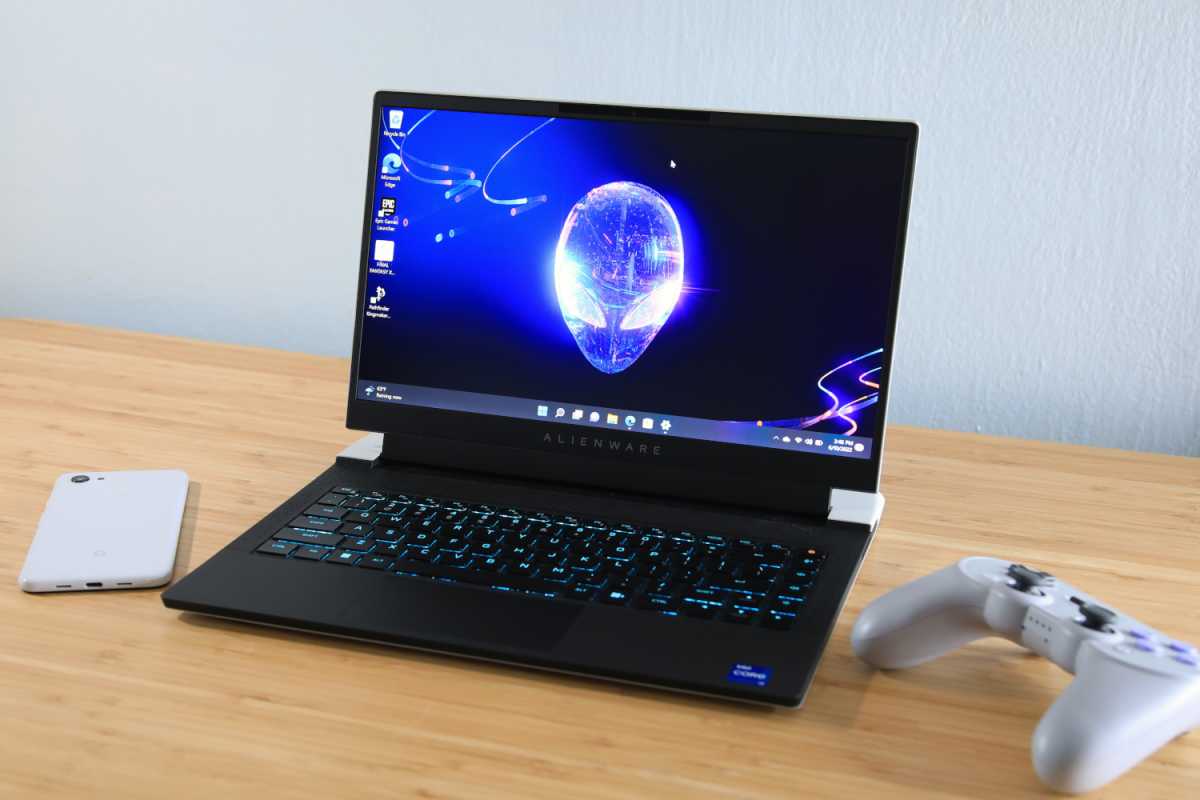
IDG / Matthew Smith
Every Alienware x14 has the same display: a 1080p, 144Hz, non-touch IPS LCD screen. It supports Nvidia G-Sync as well as Advanced Optimus, so it can switch to the Intel integrated graphics to conserve power when the Nvidia GPU’s grunt isn’t required.
A conventional 1080p IPS LCD doesn’t sound exciting in 2022, but the x14’s display is as good as the technology gets. It has extremely accurate color, a massive color gamut, a bright of up to 420 nits, and an anti-glare coat. The display is so good it can easily be used for photo or video editing, making the x14 a reasonable choice for content creators in need of a highly portable mobile workstation.
Cramming 1080p into a 14-inch means a pixel density of about 158 pixels per inch. That’s just a few pixels short of a 4K 27-inch monitor. Games look crisp with excellent detail in textures and sharp polygon edges. The only problem is the display’s lack of contrast, which snaps depth from dark scenes. However, the x14 does perform better than most LCD screens.
Audio quality is not as impressive. The speakers provide a clear presentation that rarely becomes muddy, but there’s a serious lack of bass. Action scenes and bass-heavy music can sound hollow and distant.
Webcam, microphone, biometrics
The Alienware x14 has a basic 720p webcam. It produces a soft, dull image that has serious trouble handling low-light or mixed-lighting situations. Though fine for occasional video calls, you’ll need an external webcam to look your best.
Audio recording is handled by a dual-array microphone. It picks up acceptable audio quality, though recording will always sound more distant and obscure than with a stand-alone microphone. Low-volume background noise is usually eliminated, but sharp or loud noise will get through..
An IR camera is included and enables Windows Hello facial recognition login. This is a great extra that’s rarely found on gaming laptops. It’s the quickest and arguably most secure option for biometric login.
Connectivity

IDG / Matthew Smith
Though slim, the Alienware x14 offers excellent physical connectivity. It includes two USB-C ports that support Thunderbolt 4, USB4, DisplayPort, and up to 15 watts of Power Delivery. One additional USB-C port supports USB 3.2 Gen 2, DisplayPort, and up to 15 watts of Power Delivery.
Video output is handled over either the USB-C ports or a single HDMI 2.1 output. It’s good to see HDMI 2.1 is included, since this helps make the most of a HDMI 2.1 monitor or HDTV.
Additional options include a single USB-A 3.2 Gen 1 port and a MicroSD card reader. The limited number of USB-A ports could be a sore point, since many PC gaming peripherals use USB-A. I had to use a USB-C hub to connect my flight stick for Microsoft Flight Simulator.
An Ethernet port is not included, either, though a physical Ethernet connection is possible through a USB-C adapter or USB-C hub.
The lack of Ethernet is partially excused by the x14’s excellent Wi-Fi. It supports Wi-Fi 6E which, at short ranges, can achieve connection speeds above Gigabit Ethernet. You’ll need a high-end Wi-Fi 6E router to make the most of this feature, however. Bluetooth 5.2 is also available.
Performance
The base Alienware x14 ships with an Intel Core i5-12500H processor and Nvidia RTX 3050 GPU, but my review sample was upgraded to a Core i7-12700H processor with RTX 3060 GPU. This upgrade adds a rather modest $500 to the price. My sample was also equipped with a 1TB solid state drive and 32GB of RAM.
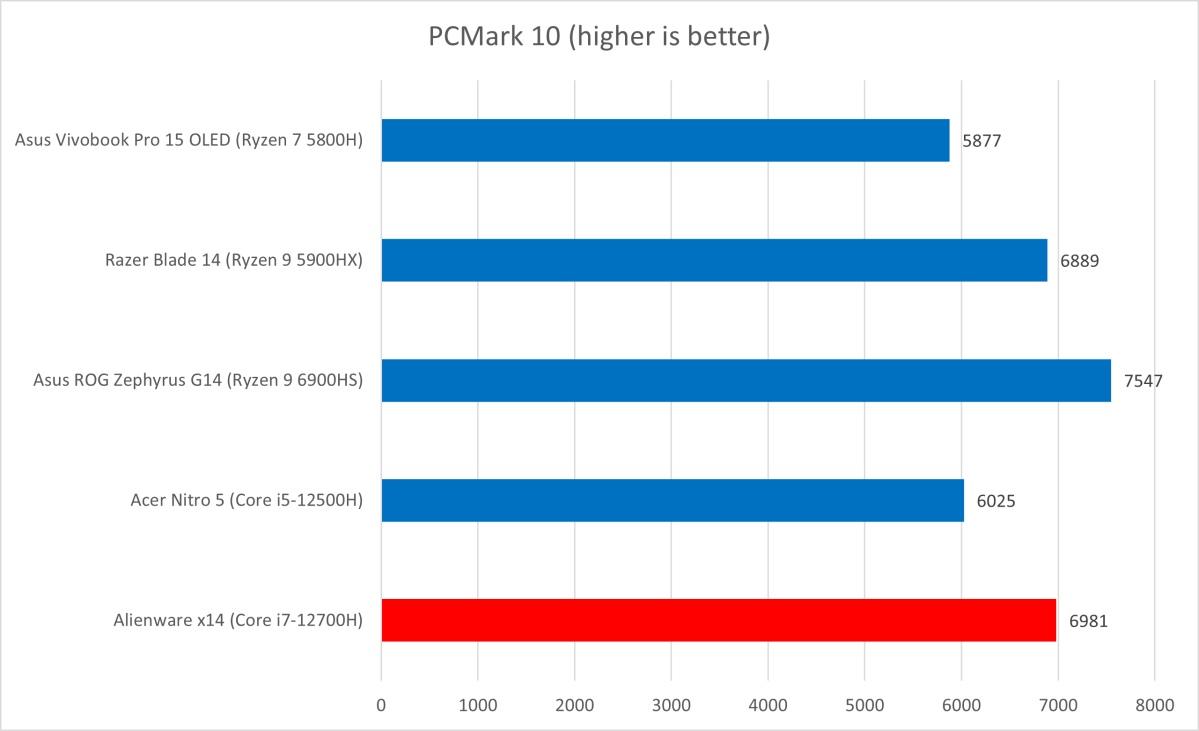
IDG / Matthew Smith
My performance tests began with PCMark 10, a synthetic test that depends heavily on processor performance but is more balanced between single-core and multi-core performance than some other tests.
The Alienware x14 does well here, hitting a score of 6,981. This is behind the Asus ROG Zephyrus G14 with the latest AMD Ryzen 6900HS processor, but ahead of the Razer Blade 14 with outgoing Ryzen 9 5900HX. The x14 easily beats the larger, less expensive Acer Nitro 5 with Core i5-12500H.

IDG / Matthew Smith
The Intel Core i7-12700H leaps ahead in Cinebench R20, squeaking out a slight win over the Asus ROG Zephyrus G14 and easily beating the older Razer Blade 14. This is a very strong result overall, and indicates the Alienware x14 is well equipped to handle demanding productivity applications.

IDG / Matthew Smith
Handbrake turns in another solid result for the Alienware x14 and flexes the muscles of Intel’s new Core i7-12700H processor with six performance cores and eight efficient cores. The x14’s thin design seems no obstacle for performance in multi-threaded workloads.
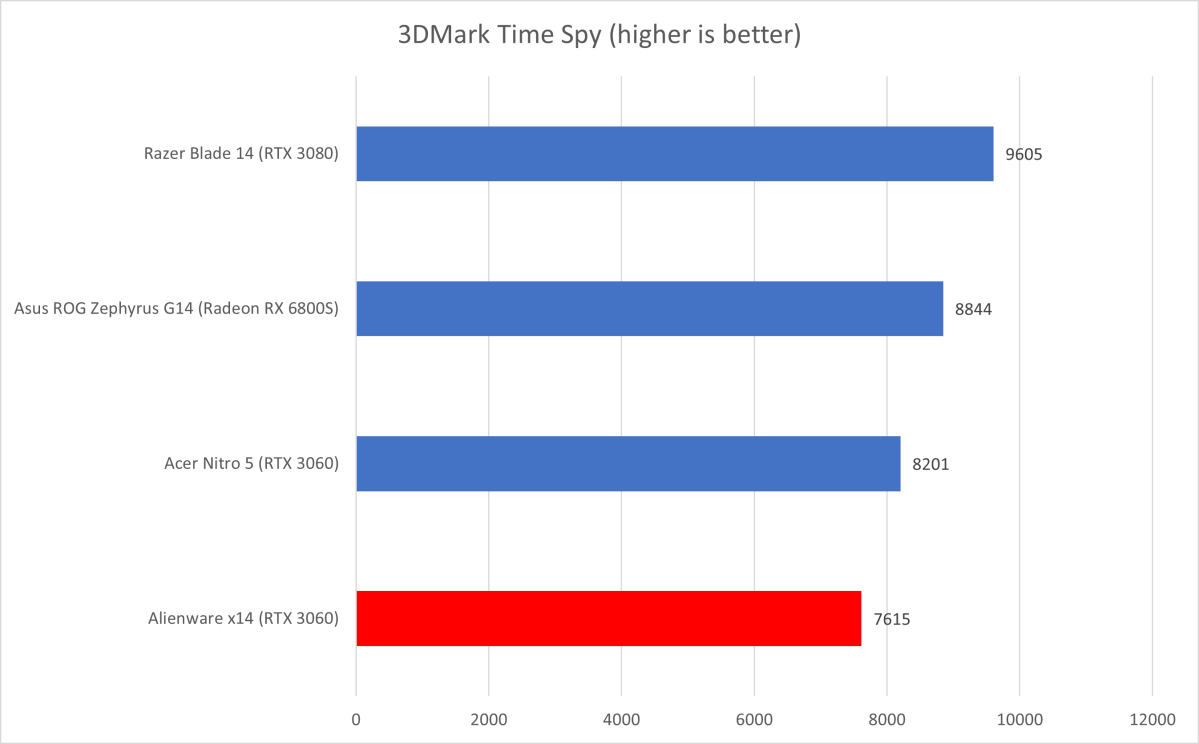
IDG / Matthew Smith
Our first graphics test, 3DMark Time Spy, produces a less favorable result for Alienware. The x14’s final score of 7,615 isn’t bad but does come behind the Acer Nitro 5, a larger but less expensive laptop with the RTX 3060 GPU. It’s also behind Asus ROG Zephyrus G14 and Razer Blade 14, both of which we tested with more powerful GPU options not available to th Alienware.

IDG / Matthew Smith
Our first real-world gaming laptop, Rise of the Tomb Raider, reached an average of 103 frames per second at 1080p resolution with detail at Very High. This is a good result, squeezing out a small victory over the Asus ROG Zephyrus G14 and Razer Blade 14. It’s possible this represents a processor bottleneck that keeps the Asus and Razer systems from making the most of their superior GPUs.
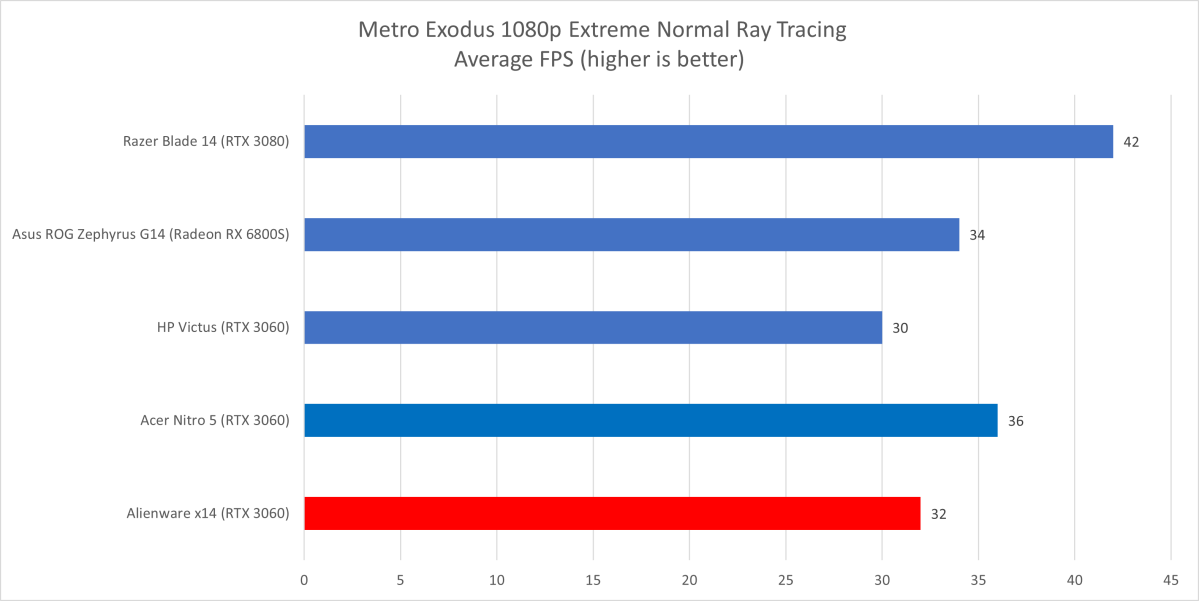
IDG / Matthew Smith
We end on Metro Exodus Enhanced Edition, an extremely demanding benchmark even with Ray Tracing set to its lowest “normal” preset. The Alienware x14 does manage to hit an average above 30 frames per second, but finds itself behind the more powerful Asus ROG Zephyrus G14 and Razer Blade 14.
On the whole, the Alienware x14 delivers good performance for a laptop of its size. It’s generally behind the quickest small laptops, but this is mitigated by the x14’s fair pricing. You’d be hard pressed to see better results from a 14-inch laptop sold at $2,000. The x14 also does well in processor tests, which may appeal to content creators who need a fast but compact laptop.
Battery life
A large 80 watt-hour battery is crammed in the Alienware x14’s small frame. This helps the laptop cope with its demanding hardware, but battery life remains less than lengthy in taxing situations.
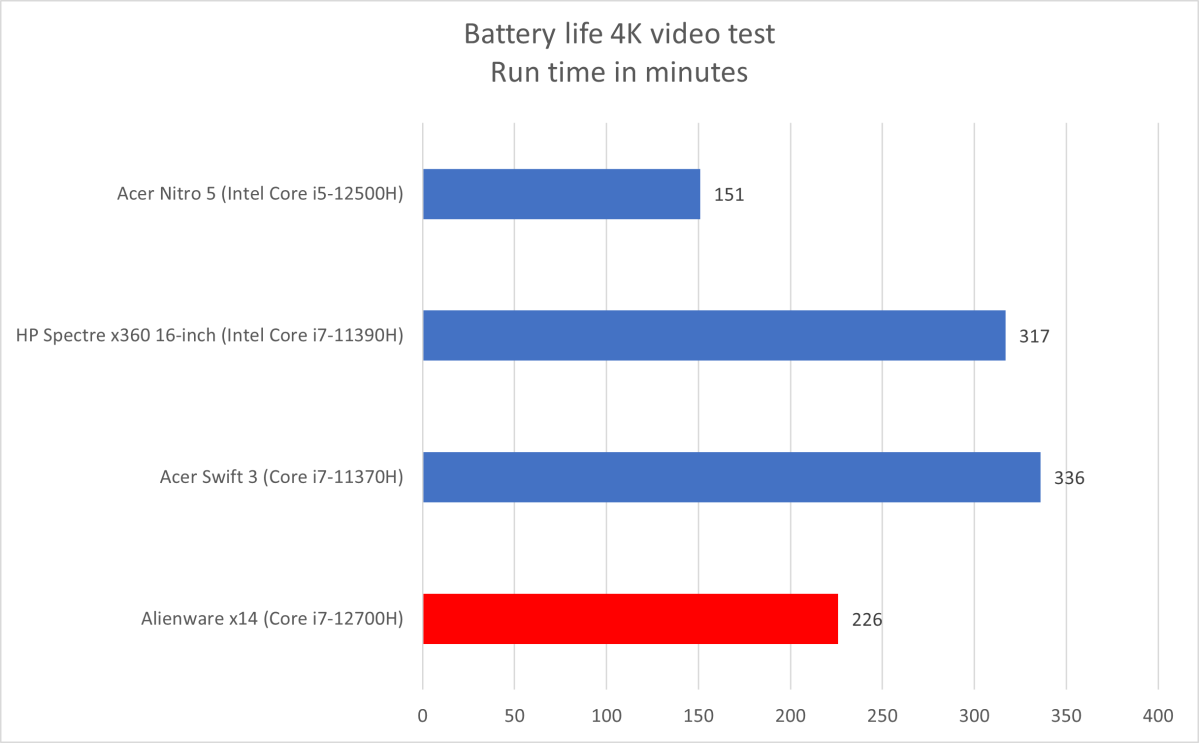
IDG / Matthew Smith
Our standard battery life test, which loops a 4K video of Tears of Steel with the display set to a brightness of 200 nits, ate through the battery in three hours and 46 minutes. This is better than many games laptops with similar hardware but still not outstanding overall.
However, real-world results can vary significantly depending on how the laptop is used. A demanding 3D game can easily drain the battery in under two hours, but browsing the web may extend battery life to five or six hours. The inclusion of Nvidia Advanced Optimus, which can switch off the discrete GPU when it’s not needed, helps extend battery life in light-load situations.
Fan noise and thermals
Cramming powerful hardware into a slim gaming laptop is never easy. Reducing size means less space to spread out a thermal load and less airflow. Alienware combats this with vapor-chamber cooling and a gallium-silicone thermal interface, but it’s not enough.
The Alienware x14’s fan is a constant companion at its default settings and, at high load, becomes a whirlwind of noise and heat. This isn’t the loudest fan ever but its high-pitched character is difficult to ignore.
Alienware’s bundled software has several thermal modes including a Quiet setting. It does reduce fan noise. With Quiet on, the fan is often hard to hear at idle. Demanding loads lead to lots of fan noise, but it’s tolerable. However, Quiet mode takes a chunk out of performance. The RTX 3060 performs more like an RTX 3050 when Quiet mode is on. CPU performance is even worse off, cut roughly in half compared to Balanced mode.
This is acceptable when playing older games, but players looking to enjoy Metro Exodus with ray-tracing (or any demanding game) will need to put up with noise.
Conclusion
The Alienware’s x14 is the world’s thinnest 14-inch gaming laptop. This is a blessing and a curse. Though portable and sleek, the x14 can’t brush aside the fundamental physics problem of a laptop this small. It’s loud, runs hot, and performs no better than a budget gaming laptop with a 15-inch display and RTX 3060 GPU.
Still, the x14 is an admirable performer given its size and specifications. On paper the x14 should be blown away by alternatives with more powerful GPUs, like the Asus ROG Zephyrus G14 and Razer Blade 14, but real-world results place the Alienware close to its competition. The x14 is also properly priced, with the base model undercutting the Razer Blade 14 by $500.
It all comes down to this: do you need a thin 14-inch gaming laptop? If so, the Alienware x14 is a great choice, but if not, go for a 15-inch model.
For all the latest Technology News Click Here
For the latest news and updates, follow us on Google News.

